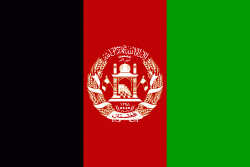Musa Qala (Mūsá Qal‘ah)
Musa Qala (موسی کلا; "Fortress of Moses") is a town and the district centre of Musa Qala District in Helmand Province, Afghanistan. It is located at 32.4433°N, 64.7444°W and at an altitude of 1,043 m in the valley of Musa Qala River in the central western part of the district. Its population has been reported in the British press to be both 2,000 and 20,000. It is in a desolate area, populated by native Pashtun tribes.
With virtually no rainfall during the year, Musa Qala features a cold desert climate (BWk) under the Köppen climate classification. The average temperature in Musa Qala is 17.6 °C, while the annual precipitation averages 159 mm.
July is the warmest month of the year with an average temperature of 30.3 °C. The coldest month January has an average temperature of 4.7 °C.
With virtually no rainfall during the year, Musa Qala features a cold desert climate (BWk) under the Köppen climate classification. The average temperature in Musa Qala is 17.6 °C, while the annual precipitation averages 159 mm.
July is the warmest month of the year with an average temperature of 30.3 °C. The coldest month January has an average temperature of 4.7 °C.
Map - Musa Qala (Mūsá Qal‘ah)
Map
Country - Afghanistan
 |
 |
| Flag of Afghanistan | |
Human habitation in Afghanistan dates back to the Middle Paleolithic era, and the country's strategic location along the historic Silk Road has led it to being described, picturesquely, as the ‘roundabout of the ancient world’. Popularly referred to as the graveyard of empires, the land has historically been home to various peoples and has witnessed numerous military campaigns, including those by the Persians, Alexander the Great, the Maurya Empire, Arab Muslims, the Mongols, the British, the Soviet Union, and most recently by a US-led coalition. Afghanistan also served as the source from which the Greco-Bactrians and the Mughals, amongst others, rose to form major empires. The various conquests and periods in both the Iranian and Indian cultural spheres made the area a center for Zoroastrianism, Buddhism, Hinduism, and later Islam throughout history.
Currency / Language
| ISO | Currency | Symbol | Significant figures |
|---|---|---|---|
| AFN | Afghan afghani | Ø‹ | 2 |
| ISO | Language |
|---|---|
| PS | Pashto language |
| FA | Persian language |
| TK | Turkmen language |
| UZ | Uzbek language |















